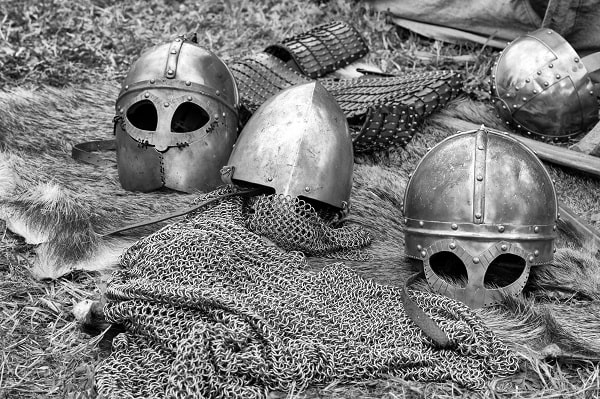When I was younger, my dad used a lot of analogies to explain ideas.
It’s a practice I’ve since adopted and find very helpful whenever I need to remember certain abstract concepts in more concrete terms.
Here’s an idea that I’ve held for quite some time and once I’d love to share with you.
It’s called a financial fortress.
Table of Contents
What is a Financial Fortress?
Like it or not, but you’re constantly under financial attack. I don’t mean from infomercials trying to sell you things or salespeople trying to outmaneuver you at the negotiation table, I mean genuine bonafide financial emergencies.
Whether it’s your kid coming home with some weird rash and you need to visit urgent care or your car rolls over a nail and now you have to spend $40 at the tire place to get it plugged, “minor” emergencies happen all the freaking time.
Then there are the major emergencies, like finding a lump in a place where lumps shouldn’t be or sliding on black ice and totaling your car.
Each of those is an assault on your money. To protect yourself, it’s best to think of your finances as a fortress and set up your defenses accordingly.
Your fortress is how you think of your money and how you’ll deploy it in response to an emergency.
Moat – Checking Account

A moat is a body of water that surrounds a castle. Maybe it has a dragon in it or some other large hungry lizard, but mostly it’s full of very hungry alligators.
As your first line of defense, your checking and savings accounts take the brunt of all your expenses. You might charge it to a credit card but you pay for it with these accounts. Your rent/mortgage, your utility bills, your grocery bills – all come from this account.
This is the account that also gets “replenished” first, with your paychecks or other sources of income.
The key to your moat is the liquidity (ha! get it???). You don’t want it locked up in stocks or CDs or anything like that, because it’s what you call on first when there’s a need. Put it in a high yield savings account, get your 1%, and let it be. It’s the cost of doing business.
Outer Wall – Emergency Fund

You can handle the little things with your Moat, but your Outer Wall is what you use to defend against the bigger things. Car accident, job loss, major home repair, forced move, etc — these are the domain of your emergency fund.
The enemy has gotten past your moat and is not testing your walls. The emergency fund is crucial because these are expenses that exceed what you might spend in a month on typical expenses.
You should have a minimum of 3 months in an emergency fund and I prefer 6-12 months, but that’ll depend on your assessment of your financial risks.
Your outer wall’s funds don’t need to be zero-day liquid (like a checking account) but you don’t want it locked up too long. I prefer a CD ladder for emergency funds when the rates are better.
Inner Wall – Investment & Retirement Assets

The raiders are over your moat, eaten your alligators, and breached that outer wall – here’s where things get messy. If your situation is dire enough to require it, your inner wall is your taxable investment accounts and your retirement assets.
Fortunately, you will have seen this coming. Your emergency fund gives you time to prepare, hopefully six to twelve months, and so you can liquidate some of your assets in a more orderly fashion rather than having a fire sale.
You will want to liquidate long term taxable investments first (assets held for over a year), followed by short term (assets held for less than a year), then turn towards the retirement assets since those have a 10% penalty if liquidated before retirement.
There are exceptions to the penalties for early withdrawal, such as if it is a medical emergency, so review those carefully and adjust your liquidation schedule accordingly.
Your Knights – Credit Cards & Insurance

Sprinkled throughout your kingdom will be your knights, there to deal with the smaller issues and give you a little breathing room (up to 30 days) as you organize your plan.
You shouldn’t rely on credit cards to solve all of your financial issues, they come at a high price should you carry a balance, but they can be deployed as a useful tool in solving problems.
I try to pay for everything with a credit card, so I get the rewards, then I pay off the statement in full every month. It’s a proxy for my moat and I get a small discount, as rewards, in the process. If you don’t carry a balance, it’ll give you a grace period as well.
Right next to my credit cards are various insurance policies that protect me against specific attacks in specific areas. I have auto insurance to protect my car, homeowner’s insurance to protect my house, disability insurance to protect my income should I become disabled, travel insurance if I need it for my vacations, and life insurance to protect my family against debtors should I perish. This isn’t an exhaustive list but should get you started on covering what you might need.
This is how I think about insurance – it buys me peace of mind. Should I suffer a covered event, insurance protects me and I don’t have to rely on an emergency fund or credit cards for the short term.
If something is so serious that it blows through all of your defenses, credit cards can be the last line of defense. When things are dire, turning towards unsecured credit is better than the alternatives.
The High Tower – Your Hard Assets

To finish off the fortress analogy, we have the high tower. These are your hard assets that you will liquidate to stave off ruin.
These are your possessions, jewelry, your car, your house… in that order. It isn’t always the last line, you will want to sell jewelry and other possessions before you max out your credit cards or sell off retirement assets, but it applies to your house or your car.
Not an absolute rule but for illustrative purposes, I think you can see where I’m going.
Having this framework can help you see how complete your financial defenses are if you come under financial attack. I always like having financial emergency plans, like what you will do if you lose your job, before I need them. This analogy just paints the concept in a convenient picture.
What do you think? How fortified is your tower?




Go Finance Yourself! says
We have a well fortified tower. I keep a few thousand in cash for a rainy day. Outside of that, our regular income and the lag we receive on credit cards can pay for minor and moderate unexpected costs. After that, we have after-tax investments that can be tapped, a line of credit with a 3.5% rate, home equity, and roth contributions if worst comes to worst. We have about $200k that can be accessed pretty easily with no penalties.
I’m curious what length CDs you use in your ladder and what your average yield is now.
I don’t ladder CDs now because the yield is so poor (2% for a 5 yr CD?) but I did back when savings accounts yielded 5%.
Brian says
A great analogy. We have a financial fortress now, but for years we were living in a financial shack. 🙂 Once we got organized and got rid f debt and built weather the fortress became a reality.
Haha, well for what it’s worth, you don’t just wake up in a fortress. It’s built brick by brick. 🙂
Lars-Christian says
I like your analogy, and envisioning it really makes evaluating your finances a more vivid experience. My personal fortress is solid enough to the extent that I hope to avoid having to employ my knights by necessity any time soon 😉
Making Your Money Matter says
Great analogy! I wonder what insurance policies would be in the analogy? Maybe the weapons that keep the fortress protected from attack when under siege? I’m working on my castle-it’s more of just a plain old house at this point, but I do believe it has a good foundation :).
Ooooh that’s a great point, I need to integrate that somehow because insurance is very important. Thank you!
Chadnudj says
I would never include retirement savings in your financial fortress….and I certainly wouldn’t put them as the inner wall as something to use BEFORE credit cards, etc. Arguably, they should be classified as untouchable, or as nuclear weapons in your fortress (i.e. untouchable because of mutually assured destruction).
Why? Because of the 10% penalty you mentioned in part, but also this — if you’re facing an emergency serious enough that you’d need to consider touching your retirement accounts, you’re arguably facing bankruptcy, and retirement accounts are bankruptcy protected. In other words, if you’ve ran up all your credit cards/have debt and can’t pay it, and are forced to declare bankruptcy, you will come out of bankruptcy debt free AND with your full retirement accounts….vs. liquidating your retirement accounts, paying that 10% fee along the way, and STILL likely facing bankruptcy if the emergency is that severe.
So, pro-tip — NEVER touch your retirement accounts UNTIL you’re retiring. Once the money’s in there, it’s safe, and you should find other “weapons/defenses” to fend off emergencies.
Well, the knights are sprinkled all throughout – they were just listed in that part of the post not to imply they should be used before or after something else. I like the idea of seeing them as nuclear weapons, though it breaks the medieval analogy! 🙂
So here’s where philosophy might differ, I’d rather liquidate my retirement funds than sell my house. I’d rather liquidate my retirement funds than sell my car and try to find out how to move around without it. So each person’s financial fortress will be different but this might help them think about them in different ways.
Yes the retirement account is safe from bankruptcy, which is a very important distinction (and in some places like Florida, your home is safe from bankruptcy too); so you have to build your fortress accordingly.
Alejandro Fernandez says
A beautiful post. Keep up the good work and greetings from the Dominican Republic!
FinancePatriot says
I think the 10% penalty is not as big a deal as some think it is.
Let’s assume that you don’t pay the penalty, and do a Roth ladder instead at the 15% federal tax bracket, of $50,000. You will pay $7,500 in income tax. That’s $7,500 that could have been invested, at 9.7% compounded return, over the next five years.
Now let’s say you simply let that $50,000 stay in your traditional IRA. You can then go ahead and withdraw that amount after five years of compounded growth. Even though you pay a 10% penalty, let’s say you have no other income. Your average tax rate on this is quite low. So the overall taxes you pay on this withdrawal is also, relatively, quite low. My early retirement calculations do actually include some 10% penalty payments.
Yeah it’s low, given the circumstances, but it’s 10% higher than you would’ve, in theory. You’d also be without money if you didn’t do it. 🙂
Mr. Grumby says
I like this analogy. I am working with on of our nieces on her financial situation and I think this post will help her.
Howch says
Credit cards can actually give you up to 45 days of breathing room. If a purchase is made on the first day of the billing cycle, payment is not due generally for two weeks after the end of the 30 day billing cycle.
Ms ZiYou says
I’m not usually one for fictional analogies, but this one really worked for me. Must be the castle, I love castle or two.
Castles are awesome! As awesome as catapults!
TJ says
Love your story. Am going to go back and read it a few more times before moving on.
I also have a few layers of defenses in my financial fortress but they aren’t as stout as I would like them to be, yet. So far, they have been well used as I have a few older buildings I’m responsible for and the maintenance calls never seem to slow down.
Reading other bloggers, they don’t seem to think the layers are necessary. I have always included them and felt silly even talking about them. Other bloggers seem to think the 4% rule of their entire savings will get then through whatever comes up. I agree more with your story.
I am new to your site so haven’t checked things out very much, yet. Are you still working or retired? If still working, what will you consider your “retirement” funds in deciding when it’s safe to retire? I get lost here. When will I have enough? My ROTH is my “retirement” funds and work with that as my pile for retirement. My other funds (high towers) are getting sizable and wonder if I should include them in my calculations. Today I figure I will work until I can’t and hope I have enough.
Personal Capital has helped me feel more secure, and it tells me I’m in “excellent shape” with my current retirement plans, but my “high towers” could very easily destroy everything if they came down, which could happen. When do you say “enough?”
Most of my work involves this blog, so I work but not in the traditional 9-to-5 sense. I view my retirement as my 401k and Roth funds, though it’s not restricted to that since we’ve accumulated assets in a taxable brokerage account too. I’m not sure the distinction is important for us though it’s worth noting that each account is taxed differently.
The question of “enough” is always tough. You can view it as a strictly financial issue – start with 4% but adjust as necessary.
The bigger question is what would you do if you “retired.” There are a lot of hours in the day and you need to find something fulfilling and challenging if you don’t want to become unmoored without work.